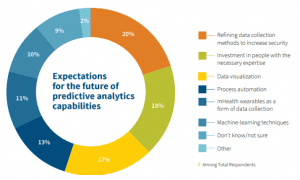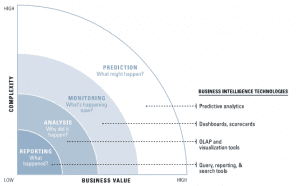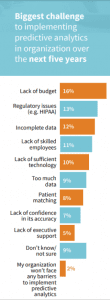[vc_row][vc_column][vc_column_text]
What is Predictive Analytics?
Predictive analytics hasn’t just changed the game for marketers, it has fundamentally reinvented it. This is due to the fact that predictive analytics isn’t just a method of leveraging customer data to launch targeted communications and campaigns. On an even deeper level, predictive analytics has the potential to become an engine that transcends marketing and can drive overall business strategy into the future.
While many organisations are implementing predictive marketing analytics and seeing incremental gains, such as an uptake in customer retention rates or improved customer engagement scores, they may not be taking advantage of the full revenue and profits potential that predictive marketing analytics can ultimately deliver.
Consider the power of predictive analytics in the following examples:
- An Irish bank uses predictive analytics to increase campaign response rates by 50%, cut customer acquisition costs by 14% and boost overall campaign ROI by 20%.
- An airline increased revenue and customer satisfaction by better estimating the number of customers who wouldn’t show up for a flight. This reduced the number of overbooked flights that required re-accommodating passengers as well as the number of empty seats.
As these examples show, predictive analytics can help companies optimise existing processes, better understand customer behavior, identify unexpected opportunities, and anticipate problems before they happen.
Predictive and prescriptive analytics are the most talked about analytics trends among Business Intelligence professionals, especially since big data has become the main focus of analytics processes and is being leveraged not just by large enterprises, but by small and medium-sized businesses also. Industries harness predictive analytics in different ways; airlines use it to decide how many tickets to sell at each price for a flight, hotels use it to predict the number of guests they can expect on any given night in order to adjust prices to maximize occupancy and increase revenue, whereas bankers use it to generate a credit score that includes all of the relevant data needed to calculate a person’s creditworthiness. There are plenty of big data examples in real life which shape the world around us be it in the customer journey or managing customers’ data.

Definitition
Predictive analytics is a term used to describe a variety of statistical and analytical techniques used to develop models that predict future events. In predictive analytics, business intelligence (BI) technologies are used to uncover relationships and patterns within large volumes of data that can be used to predict behavior and events. Unlike other BI technologies, predictive analytics is forward-looking, using past events to anticipate the future.
How it works?
Predictive analytics is the process of making educated predictions based on data. This process uses data along with analysis, statistics, and machine learning techniques to create a predictive model for forecasting future events. The term “predictive analytics” describes the application of a statistical or machine learning technique to create a quantitative prediction about the future.
The predictions are most often values suggesting the likelihood that a particular behavior or event will take place in the future. Therefore, with the right data, you can accurately predict the probability of an event occurring with a high degree of certainty.

The Business Value of Predictive Analytics
-
Maximising Return On Investment

Predictive analytics can be used to help your company increase return on investment (ROI) through targeted marketing campaigns, improved risk assessment and management, reducing operational costs, and making actionable decisions.
By using predictive analytics, companies can accurately assess the present state of their business, optimise their operations, and compete more effectively in gaining market share. By assessing the predicted outcomes of future events, and using that information to their advantage, companies can improve their revenue and enhance their business performance as a whole. Deploying successful predictive models can help companies minimise risk and increase revenue across all sectors of the business.
Increasing the number of successful business decisions your company makes will ultimately lead to better business performance. Informed decisions backed up with accurate predictive models increases the likelihood of making successful business decisions. This further increases the confidence of management in making decisions that come about as a result of deploying predictive analytics models. Better decision-making, on the basis of more accurate information, is the core of predictive analytics.
The more these predictive models are deployed and used, the more relevant and trusted they become and the more they contribute to the success of the business. Successful predictive models help decision makers to pursue consistent increases in longer-term ROI.
-
Predict Customer Behaviour
In marketing, knowing your customer (KYC) is the name of the game. The more you understand about what your customers want , the easier it is to reach out to them across various channels with the right interaction at the right time.
Using predictive techniques guided by the use of machine learning and artificial intelligence, predictive modeling helps marketers assess future customer behaviors by identifying patterns and similarities between variables in the data. For example, regression analysis can be used to identify correlations between customers’ past purchasing behaviors to determine the probability of future purchases. Predictive models can also help identify dissatisfied customers you’re in danger of losing as well as identify excited customers who may be ready to buy. Running customer data through predictive models can help you better anticipate behavior to better inform marketing strategy.
-
Lead generation
Unqualified leads can end up costing your company a lot of money as a result of the time and effort spent in pursuing these leads to no avail. With predictive analytics, business intelligence professionals can avoid this issue and focus marketing efforts solely on more promising leads by using algorithms to help them qualify leads by prioritising known prospects and accounts based on their likelihood of making a purchase decision. Identification models find prospects who have similarities with existing buyers and are as a result more likely to make a purchase decision, therefore, maximising opportunities for new sales.
Furthermore, insights from predictive analysis can help sales teams to concentrate on and nurture their most profitable customers by finding prospects who show the most potential, and giving their sales teams valuable insights into who to talk to next and which prospects will be most likely to close a deal. Also, if your company has limited funds available, predictive analytics can be a powerful tool to help ensure the right resources are used at the right time while forecasting high-value customers with the highest probability of buying for optimised marketing spend. Learn more about lead generation HERE.
-
Incremental Improvement v Radical Change
Although organisations occasionally make game-changing discoveries using predictive analytics, these cases are the exception rather than the rule. Organisations that approach predictive analytics with a “strike-it-rich” mentality will likely become frustrated and change course before reaping any real rewards from their use of predictive analytics.
The reality is that predictive analytics provides incremental improvement to existing business processes, not million-euro discoveries. “We achieve success in little percentages,” says a technical lead for a leading Irish telecommunications firm. She convinced her company several years ago to begin building predictive models to identify customers who might cancel their service. Predictive models have contributed to lowering our churn rate, giving us a competitive advantage against our rivals.” The company’s churn models reveal insights about customer behavior that the business uses to improve marketing and general business processes.
-
Minimise Customer Churn

Churn is the process of customer turnover or transition to a less profitable product. With customer churn rates as high as 30 percent per year in some global markets, identifying and retaining at-risk customers remains a top priority for business leaders. As markets become saturated, unhappy customers defect. This practise is becoming more and more common and a class of professional churners is beginning to emerge.
In order to combat the high cost of churn, increasingly sophisticated techniques are being employed to analyse why customers churn and which customers are most likely to churn going forward. Such information can be used to actively monitor the customer base and predict which customers may be thinking of migrating to another provider.
One of the best tools used by data analysts when attempting to predict churn rates is IBM SPSS. SPSS is a data mining and predictive modeling technology which is recognised as an industry leader in the integration of data mining technologies. Based on an intuitive, visual data flow process of analysis, models and reports can be created to tackle otherwise difficult and time-consuming problems. By applying various segmentation algorithms to group people, and using automatic clustering, anomaly detection and clustering neural network techniques, you can detect unusual patterns in your data. Once the key indicators are identified, the customers may be sorted into a ranked list of high probability to churn down to the least likely to churn, the loyal customers.
Final Thoughts
Predictive analytical models can be used to forecast marketing performance based on past campaigns, uncover opportunities to improve, better understand your customers’ behaviors and create customised experiences that wow existing and potential customers.
This agile approach to business is future-focused and a must for success in 2019 and beyond. The good news is that deploying predictive analytics solutions is neither complicated nor overly expensive. In fact, many analytics agencies offer tons of amazing solutions for both large and small companies alike.
Accurate and timely business intelligence will be a huge differentiator for companies going forward. While there are many reasons for using predictive analytics, the most persuasive is also the simplest: go beyond learning what happened and why to discovering insights about future events and you’ll be better able to serve your customers today.
To learn more about how Digital Strategy Consultants can help your business use predictive analytics and forecasting CLICK HERE
About the Author
Mark O’Connell is a digital expert working at Digital Strategy Consultants. He has a passion for strategy and for assisting organizations achieve their online goals through best practice techniques and priming them to drive competitive advantage through early adoption of emerging digital technologies. Mark holds a LL.B (BS) (Hons) in Law & Business (TCD), MSc in Data Intelligence (Fordham University, New York) and a MSc in Marketing Strategy (Antwerp Management School). His current research interests are in the field of analytics and strategy and how these disciplines can be used to drive competitive advantage. [/vc_column_text][vc_empty_space][vc_empty_space][/vc_column][/vc_row]







Recent Comments